The Indian state of Rajasthan has a rich cultural heritage. It is also the state where, it is believed, that the Rajput (warrior) clans originated. In the days of yore the state was divided into principalities.
Now, Rajasthani cuisine and consequently Rajputana cuisine is markedly different from the other cuisines that we find in India. Rajasthan has a hot and arid landscape. Much of the state is the Thar Desert. In the old days, the King, princes and their consorts would go on hunts. The meat that they shot would be cooked with minimal spices and those that were locally available. Hence, the spices used for the cooking and the ingredients were few but the meat was slow cooked for long hours over a wooden flame. Gone are those days but the legacy of the recipes still remains.
In some villages, women still use an earthen stove fired by either wood or charcoal. The aroma of the smoke infuses into the meat and gives the dish a unique smoky flavour. The advent of cooking gas has put such practices to rest but the tradition of smoking the meat continues. Only now, we do so by using more modern techniques.
Rajasthani Laal Maans – The word Laal is a colour that means ‘red’ in Hindi. Maans means meat. The dish is named Red meat because it is made using the ‘mathania red chili’ which is indigenous to Rajasthan. The chilli imparts both the colour and the flavour to the dish. The chili has a fiery and spicy taste and to be honest, not everyone can eat such spicy food. So, I substitute the mathania chilies with Kashmiri red chilies. The Kashmiri red chili imparts the same red colour but it is far less hot.
I also substitute the kachari (a wild variety of cucumber that is also native to Rajasthan) with curd as the kachari is not available readily.
This is my version of the recipe via which I pay homage to my cultural roots.
LAAL MAANS (red mutton curry)
INGREDIENTS
- 1 Kg goat meat, on the bone, cut into chunks
For marinating the goat meat pieces
- ½ cup thick yogurt/curd
- 2 tsp cumin powder
- 2 tsp coriander powder
- ¼ tsp turmeric powder
- 1 tbsp ginger-garlic paste
- 2 tbsp kashmiri red chilli powder
For cooking the Laal Maans
- 1 tsp ginger-garlic paste
- ¼ cup of ghee/clarified butter (you can also use refined oil)
- 1 tsp refined oil
- 3-4 cloves
- 7-8 peppercorns
- 1 tsp shahi jeera (black cumin seeds)
- 3-4 green cardamoms, pods opened
- 2 black cardamoms
- 1 stick daal chini (cinnamon)
- 2 bay leaves
- 1 dried red chilli
- 2-3 pieces star anise
- Half a flower of javitri/mace (optional)
- 4 medium sized onions finely chopped or pureed.
- A handful of chopped coriander for garnish
- ½ tsp lemon juice
- 2 green chillies, slit
- Salt to taste
- ½ tsp garam masala
- 1 tsp kashmiri red chili (optional)
For smoking the meat (post cooking)
- 1 medium sized piece of charcoal
- 2-3 cloves
- 1 tsp ghee/clarified butter
Note – I prefer to marinate the meat overnight as that really helps infuse all the spices into it.
METHOD
Marinating the meat
In a large mixing bowl add the spices for marinating the meat and add the meat. Mix well (I prefer to use my hands as then I can rub the spices into the meat skin. If you also do so then be sure to wash your hands really well as the marinade contains a lot of chillies). Cover and keep aside for at least an hour or overnight in the fridge.

Cooking the meat
- In a heavy bottomed pressure cooker, heat the ghee. Add 1 tsp refined oil to it so that the ghee does not burn.
- Once the oil is hot, add the shahi jeera, cloves, bay leaves, cinnamon, peppercorns, mace, dried red chilli, slit green chillies, star anise, green and black cardamoms. Stir to infuse the flavour.

- Tip in the onions and fry them till they are golden brown. Then add 1 tsp ginger – garlic paste (that will be enough because we also added the ginger garlic paste to the marinade) and fry that also for about 1-2 minutes.

- Add the marinated goat’s meat (marinade and all) and stir it well to combine the meat and the onion mix. Roast the meat for about 5 minutes.

- Add salt and water. Note – the water should be sufficient to not only cover the meat pieces but also it should come about 1 ½ inches above the meat.
- Close the lid of the cooker and give one whistle on high. After that lower the heat to medium and give 6-7 more whistles on medium heat. Allow the pressure to release on its own. Once the lid opens, check the tenderness of the meat. Sometimes the meat remains undone depending on whether you are using frozen stock or fresh one. If the meat is undone, then add a little more water, close the lid and give a few more whistles.
- After the meat is cooked, stir in the garam masala and lime juice. Taste the curry and if you wish then you can add more kashmiri red chili.

- The main dish is now ready but if you wish to induce the smoky flavour then –
Smoking the meat
- Heat a piece of charcoal on the stove/on open fire. Once it is hot and glowing, remove it and place it in a metallic bowl.
- Lower the bowl gently onto the prepared mutton curry in the pressure cooker. Let it sit on the top.
- Add 2-3 cloves to the coal and pour 1 tsp of ghee/melted butter on to it.
- The coal will release a lot of smoke. Immediately cover the cooker with the lid and keep covered for about 2 minutes to allow the smoke to infuse in the dish.
- Garnish with coriander leaves and lemon wedges and serve hot with chapattis or rice.
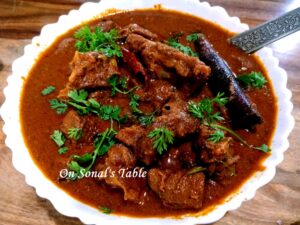

 Sonal Singh On Sonal's Table
Sonal Singh On Sonal's Table

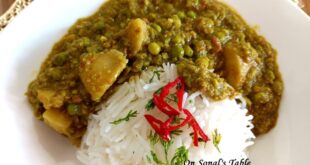
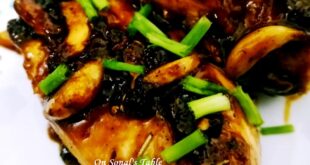
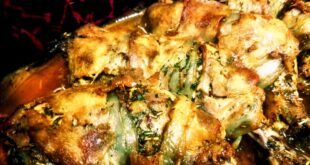
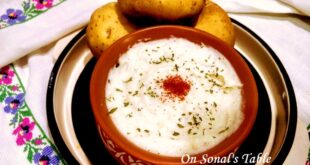
Oh! This looks absolutely amazing. I will one day try this.